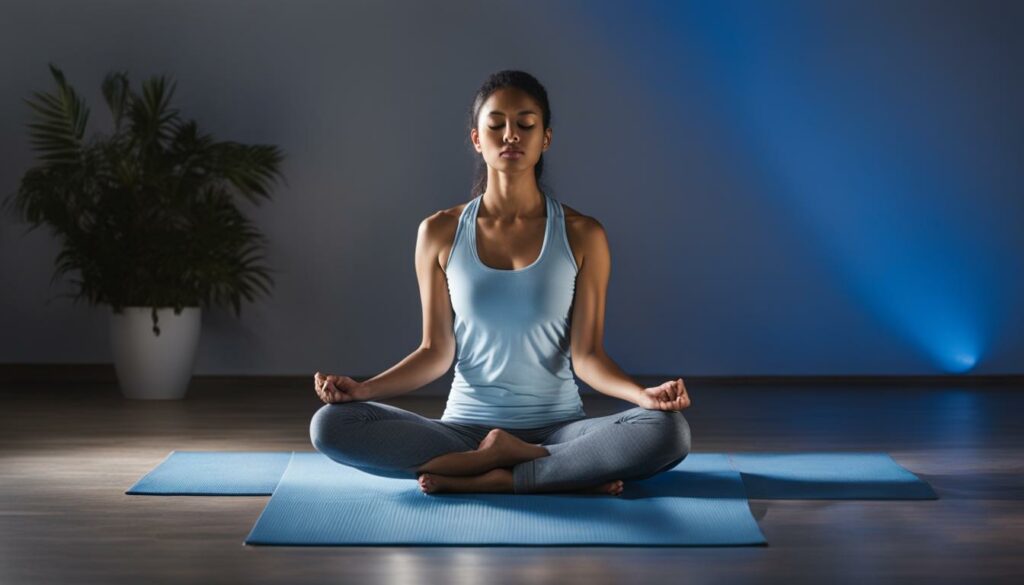Stress is an inevitable part of life, but that doesn’t mean we have to let it consume us. As I have discovered, breathing exercises are a powerful tool for managing stress and promoting a sense of calm. By intentionally manipulating our breath, we can tap into the stress-relieving and anxiety-reducing benefits of breathwork. In this article, I will share with you the science behind these techniques and provide step-by-step instructions for various breathing exercises that can offer immediate stress relief.
Key Takeaways:
- Breathing exercises are effective in relieving stress and promoting calm.
- These techniques involve manipulating the breath to activate relaxation responses.
- By incorporating breathing exercises into your daily routine, you can effectively manage stress and reduce anxiety.
- Creating a conducive environment and following best practices can maximize the benefits of breathwork.
- There are various breathing techniques that can be used for immediate stress relief and long-term stress management.
By the end of this article, you will have a comprehensive understanding of breathing exercises for stress relief and be equipped with practical tools to incorporate breathwork into your daily life. Let’s dive in!
Understanding the Power of Breath for Stress Management
When it comes to managing stress, the power of breath should not be underestimated. Our breath is not just a simple act of inhaling and exhaling; it holds the key to unlocking relaxation and calm in our lives. By understanding the science behind breathing and relaxation, we can tap into the potential of breathwork for effective stress management.
As an essential function of the body, breathing goes beyond the basic supply of oxygen to our cells. The way we breathe directly affects our physiological and psychological well-being. Breathwork, which involves intentional manipulation of the breath, can have a profound impact on our nervous system and activate relaxation responses.
Studies have shown that specific breathing techniques can reduce stress and anxiety by activating the parasympathetic nervous system, often referred to as the “rest and digest” response. This response helps counteract the effects of the sympathetic nervous system, also known as the “fight or flight” response, which is responsible for our stress response.
The way we breathe can influence our heart rate, blood pressure, and overall stress levels. By incorporating calming breathing exercises and breath control techniques into our daily lives, we can effectively reduce stress and cultivate a sense of calm and relaxation.
Through breath control, we can regulate our breath to slow down our heart rate, decrease blood pressure, and promote a state of calmness. This provides an effective tool for stress reduction and management.
By incorporating breathwork into our stress management practices, we can tap into the power of our breath to reduce stress and create a greater sense of well-being.
Breathing Techniques to Activate Relaxation Responses
There are specific breathing techniques that are particularly effective in activating relaxation responses in our body. By incorporating these techniques into our daily routine, we can reduce stress and promote a sense of calm. Two such techniques that have been widely studied and proven to be beneficial are diaphragmatic breathing and progressive relaxation through breath control.
The Role of Diaphragmatic Breathing
Diaphragmatic breathing, also known as belly breathing or deep breathing, involves using the diaphragm, a dome-shaped muscle located below the lungs, to fully engage the breath. This technique helps to activate the body’s natural relaxation response and counteract the effects of stress.
Progressive Relaxation Through Breath Control
Progressive relaxation through breath control is a technique that involves consciously tensing and releasing different muscle groups while focusing on the breath. By combining breath control with muscle relaxation, this technique can help reduce tension and promote a deep sense of relaxation.
By incorporating diaphragmatic breathing and progressive relaxation through breath control into your daily routine, you can harness the power of breath to activate relaxation responses and effectively manage stress.
| Technique | Description |
|---|---|
| Diaphragmatic Breathing | A technique that involves using the diaphragm to fully engage the breath and activate the body’s natural relaxation response. |
| Progressive Relaxation Through Breath Control | A technique that combines breath control with muscle relaxation to reduce tension and promote deep relaxation. |
Preparation for Effective Breathing Exercises
In order to maximize the benefits of breathing exercises, it is important to create a conducive environment and follow best practices. By taking a few simple steps, you can enhance the effectiveness and impact of your breathwork sessions. Here are some tips to help you prepare effectively for your breathing exercises:
Creating a Conducive Environment
Creating a calm and peaceful environment can greatly enhance the benefits of your breathing exercises. Here are a few suggestions to help you create the ideal atmosphere:
- Find a quiet space where you won’t be easily disturbed.
- Dim the lights or use soft, ambient lighting.
- Choose a comfortable seating position or lie down in a comfortable position.
- Play soothing music or nature sounds in the background to create a relaxing ambiance.
- Use essential oils or aromatherapy diffusers to create a calming scent in the room.
By creating a peaceful environment, you can minimize distractions and fully immerse yourself in the breathing exercises, allowing for deeper relaxation and stress relief.
Best Practices for Maximizing the Benefits of Breathwork
Follow these best practices to ensure you get the most out of your breathing exercises:
- Set aside dedicated time: Schedule a specific time for your breathwork practice and commit to it. Consistency is key for seeing long-term benefits.
- Start with a warm-up: Begin your session with a few deep, cleansing breaths to center yourself and prepare your body and mind for the exercises.
- Focus on proper technique: Pay attention to your posture and breathing technique. Relax your shoulders, keep your spine straight, and breathe deeply and fully.
- Take it slow: Allow yourself to breathe at a pace that feels comfortable and natural to you. Avoid forcing the breath or straining.
- Be present: As you engage in the breathing exercises, bring your full attention to the present moment. Let go of any distracting thoughts and simply focus on your breath.
- Practice self-compassion: Be gentle with yourself and listen to your body. If you feel any discomfort or strain, modify the exercises or take a break if needed.
By following these best practices, you can ensure a safe and effective breathwork practice that maximizes stress management and relaxation benefits.
Now that you have prepared yourself and your environment, you are ready to dive into the various breathing techniques that can help you activate relaxation responses and achieve immediate stress relief. Section 5 will explore calming breathing exercises that you can use in times of immediate stress or anxiety.
Calming Breathing Exercises for Immediate Stress Relief
In times of immediate stress or anxiety, having simple yet effective breathing exercises to turn to can be incredibly helpful. By focusing on our breath, we can activate the body’s relaxation response, calming our mind and reducing stress levels. Below, you will find a selection of calming breathing exercises that provide immediate stress relief:
- 4-7-8 Breathing Technique: This technique involves inhaling deeply through your nose for a count of 4, holding your breath for a count of 7, and exhaling slowly through your mouth for a count of 8. Repeat this cycle several times, focusing on the rhythm of your breath.
- Pursed Lip Breathing: Pursed lip breathing involves inhaling deeply through your nose and exhaling slowly through pursed lips, as if you were blowing out a candle. Focus on making the exhale longer than the inhale to promote relaxation.
- Box Breathing: Box breathing is a technique that involves inhaling deeply through your nose for a count of 4, holding your breath for a count of 4, exhaling slowly through your nose for a count of 4, and holding your breath again for a count of 4. Repeat this cycle several times, visualizing each side of the “box” as you breathe.
- Alternate Nostril Breathing: In this technique, use your right thumb to close your right nostril and inhale deeply through your left nostril. Then, use your right ring finger to close your left nostril and exhale through your right nostril. Repeat this pattern, alternating the nostril you inhale and exhale through.
Practice these calming breathing exercises whenever you feel overwhelmed or in need of immediate stress relief. Remember to find a quiet and comfortable space, close your eyes if it helps you focus, and allow yourself to fully connect with each inhale and exhale.
By incorporating these simple techniques into your daily routine, you can effectively manage stress, promote relaxation, and cultivate a greater sense of calm in your life.

Breathing exercises for stress: A Step-by-Step Guide
Deep Breathing for Stress Reduction
Deep breathing is a simple and effective technique for reducing stress and promoting a sense of calm. This technique involves taking slow, deep breaths, filling your lungs with oxygen, and releasing tension with each exhale.
To practice deep breathing:
- Find a comfortable seated position with your feet flat on the floor and your hands resting on your lap.
- Close your eyes and take a moment to relax.
- Inhale deeply through your nose, allowing your belly to rise as you fill your lungs with air.
- Exhale slowly through your mouth, releasing any tension or stress with each breath.
- Continue this deep breathing pattern, focusing on your breath and letting go of any negative thoughts or distractions.
The Equal Breathing Technique
The equal breathing technique, also known as box breathing, is a powerful method to reduce stress and promote relaxation. This technique involves inhaling, holding the breath, exhaling, and holding the breath again, all for an equal duration.
| Inhale | Hold | Exhale | Hold |
|---|---|---|---|
| Inhale deeply through your nose for a count of four. | Hold your breath for a count of four. | Exhale slowly through your mouth for a count of four. | Hold your breath for a count of four. |
Incorporating Mindfulness into Your Breathing Sessions
Mindfulness is the practice of being fully present and aware of the present moment, without judgment. By incorporating mindfulness into your breathing sessions, you can enhance the effectiveness of the exercises and deepen your sense of relaxation and calm.
To incorporate mindfulness into your breathing sessions:
- Find a quiet and comfortable space where you can focus on your breath.
- Close your eyes and take a few moments to center yourself.
- Direct your attention to your breath, noticing the sensation of the air entering and leaving your body.
- Observe your breath without trying to change it, simply allowing it to flow naturally.
- If your mind starts to wander, gently bring your focus back to your breath.
- Continue this mindful breathing practice for a few minutes, gradually extending the duration as you become more comfortable.
By incorporating deep breathing exercises, the equal breathing technique, and mindfulness into your routine, you can effectively reduce stress and promote a sense of calm. Take the time to practice these techniques regularly and embrace the transformative power of breathwork for stress relief.
Deep Breathing Techniques for Long-Term Stress Management
Deep breathing techniques are highly effective for both immediate stress relief and long-term stress management. By incorporating these techniques into your daily routine, you can cultivate resilience to stress and improve your overall well-being. Deep breathing exercises work by activating the body’s relaxation response, helping to reduce anxiety, lower blood pressure, and promote a sense of calm.
One popular deep breathing technique is diaphragmatic breathing, also known as belly breathing. With diaphragmatic breathing, you focus on expanding your belly as you inhale deeply through your nose, allowing your diaphragm to fully engage. As you exhale through your mouth, you intentionally relax your abdomen, releasing any tension or stress.
“Deep breathing exercises activate the relaxation response, helping to reduce anxiety, lower blood pressure, and promote a sense of calm.”
Another effective deep breathing technique is equal breathing, which involves inhaling and exhaling for an equal count. This rhythmic breathing pattern helps regulate your breath and bring balance to the body and mind. To practice equal breathing, inhale deeply through your nose for a count of four, then exhale through your nose for the same count. Repeat this pattern for several minutes, focusing on the sensation of your breath.
Furthermore, incorporating mindfulness into your deep breathing sessions can enhance their stress-relieving benefits. Mindful breathing involves bringing your full attention to the present moment and observing your breath without judgment. As you practice mindful deep breathing, you may notice the sensation of the air entering and leaving your body, the rise and fall of your abdomen, and the subtle changes in your breathing patterns.
By regularly practicing deep breathing techniques such as diaphragmatic breathing, equal breathing, and mindful breathing, you can develop a powerful stress management tool that can be used anytime and anywhere.

Breathwork Techniques for Stress Reduction
In addition to deep breathing, there are other breathwork techniques that can be used for stress reduction. This section will explore two such techniques: progressive muscle relaxation and the lion’s breath method.
Progressive Muscle Relaxation
Progressive muscle relaxation is a technique that involves tensing and then releasing specific muscles in the body to promote a deep state of relaxation. It is an effective method for reducing stress and relieving muscle tension.
To practice progressive muscle relaxation, find a quiet and comfortable space where you can fully relax. Begin by taking a few deep breaths to center yourself. Starting from your toes, gradually tense the muscles in your feet and hold for a few seconds before releasing the tension. Move up the body, systematically tensing and releasing each muscle group, including your legs, abdomen, arms, and face.
As you practice progressive muscle relaxation, focus on the sensation of tension leaving your body with each release. This technique can be particularly beneficial for individuals who experience physical symptoms of stress or have trouble relaxing their muscles.
The Lion’s Breath Method
The lion’s breath method is a unique breathwork technique that combines deep breathing with vocalization. This technique is known for its ability to release tension, alleviate stress, and promote a sense of emotional release.
To practice the lion’s breath method, start by sitting in a comfortable position with your back straight. Take a deep breath in through your nose, filling your lungs completely. As you exhale forcefully through your mouth, open your eyes wide, stick out your tongue, and make a “ha” sound, imitating the roar of a lion.
Repeat the lion’s breath method several times, focusing on the sensation of releasing stress and tension with each exhale. This technique can help you let go of emotional and mental burdens, leaving you feeling more grounded and centered.
By incorporating progressive muscle relaxation and the lion’s breath method into your breathwork routine, you can enhance your ability to reduce stress and promote overall well-being.
Guided Breathing Exercises for Enhanced Calm
Guided breathing exercises can be a powerful tool for enhanced calm and relaxation. By combining breathwork with visualization and structured breathing patterns, you can cultivate inner peace and tranquility.
When practicing guided breathing exercises, it is important to create a peaceful environment free from distractions. Find a quiet space where you can comfortably sit or lie down. Close your eyes, take a moment to center yourself, and focus on your breath.
One effective technique is to imagine yourself in a serene natural setting, such as a peaceful forest or a tranquil beach. Visualize the sounds, smells, and sensations of this place, allowing yourself to fully immerse in the experience. As you inhale and exhale, imagine breathing in the calmness of the surroundings and releasing any tension or stress with each breath.
In addition to visualization, incorporating structured breathing patterns can further enhance the relaxation response. One popular technique is square breathing, also known as box breathing. This technique involves inhaling for a count of four, holding the breath for a count of four, exhaling for a count of four, and holding the breath again for a count of four. Repeat this pattern several times, focusing on the rhythm of your breath and the sensation of relaxation.
Another structured breathing pattern is the 4-7-8 technique. This technique involves inhaling deeply through your nose for a count of four, holding your breath for a count of seven, and exhaling slowly through your mouth for a count of eight. This pattern helps slow down your breathing and activates the body’s relaxation response.
Remember, guided breathing exercises are meant to be a gentle practice, so listen to your body and go at your own pace. As you engage in these exercises, notice how your mind and body respond, allowing yourself to let go of tension and find a sense of calm.

Conclusion
In conclusion, integrating breathing exercises into your daily life is an effective way to manage stress and promote a sense of calm. By regularly practicing relaxation exercises for stress, you can build resilience and cultivate an overall sense of well-being.
Breathwork has been scientifically proven to significantly impact our stress levels. Through simple techniques such as deep breathing, mindfulness, and visualization, we can tap into the power of our breath to reduce anxiety and increase relaxation.
Embracing breathwork as part of a comprehensive stress management routine allows us to take control of our well-being. By dedicating a few minutes each day to practice these stress management techniques, we can enjoy the benefits of improved mental and physical health.
So why wait? Start integrating breathing exercises into your daily life today and experience the transformative effects of breathwork for yourself. Embrace the power of your breath and take proactive steps towards comprehensive stress management.
FAQ
What are breathing exercises for stress relief?
Breathing exercises for stress relief are specific techniques that involve intentional manipulation of the breath to activate relaxation responses in the body. These exercises can help reduce stress and promote a sense of calm.
How do breathing exercises impact our nervous system?
Breathing exercises, such as diaphragmatic breathing and progressive relaxation through breath control, can directly impact our nervous system by activating the relaxation response. This response helps reduce stress levels and promotes a sense of relaxation and calmness.
How can I prepare effectively for breathing exercises?
To prepare effectively for breathing exercises, it is important to create a conducive environment and follow best practices. This includes finding a quiet and comfortable place, setting aside dedicated time, and adopting a relaxed posture.
What are some calming breathing exercises for immediate stress relief?
Calming breathing exercises, such as deep breathing and equal breathing, can provide immediate stress relief. These techniques involve taking slow, deep breaths and focusing on the rhythm and depth of your breath to induce relaxation.
How can deep breathing techniques help with long-term stress management?
Deep breathing techniques, when incorporated into your daily routine, can help build resilience to stress and improve overall well-being. By practicing deep breathing regularly, you can train the body and mind to respond more effectively to stressful situations.
What are some other breathwork techniques for stress reduction?
In addition to deep breathing, other breathwork techniques like progressive muscle relaxation and the lion’s breath method can also be effective for stress reduction. These techniques combine breath control with muscle relaxation or specific breathing patterns.
How can guided breathing exercises enhance calm and relaxation?
Guided breathing exercises combine breathwork with visualization and structured breathing patterns to cultivate a deeper sense of calm and relaxation. These exercises provide guidance and help in focusing the mind, leading to enhanced relaxation and stress relief.
How can I integrate breathing exercises into my daily life for effective stress management?
To integrate breathing exercises into your daily life for effective stress management, you can set aside dedicated time for practice, incorporate breathwork into activities like yoga or meditation, and cultivate awareness of your breath throughout the day. Consistency is key to experiencing the long-term benefits of breathing techniques.
Can Breathing Exercises and Mindfulness Meditation be Used Together for Stress Relief?
Yes, breathing exercises and mindfulness meditation for stress relief can be used together effectively. Combining deep breathing techniques with the focus and presence of mindfulness meditation can create a powerful tool for combating stress and promoting relaxation. Practicing both methods together can enhance their individual benefits.
Source Links
- https://www.webmd.com/balance/stress-management/stress-relief-breathing-techniques
- https://www.nhs.uk/mental-health/self-help/guides-tools-and-activities/breathing-exercises-for-stress/
- https://www.healthline.com/health/breathing-exercise

